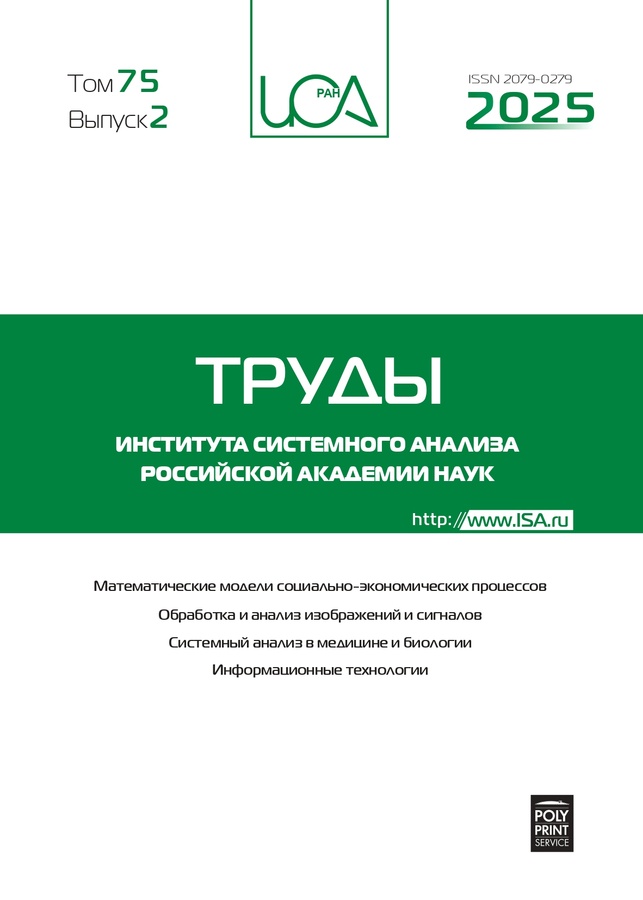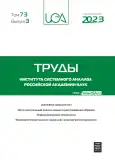Том 73, № 3 (2023)
Динамика макросистем
Системный анализ динамических состояний механических колебательных систем на основе рычажных связей
Аннотация
Развивается методология оценки динамических состояний технических объектов транспортного или технологического назначения, находящихся в условиях вибрационных нагружений. В качестве расчетных схем используются механические колебательные системы с сосредоточенные параметрами. Применяется структурный подход, в рамках которого механическим колебательным системам ставятся в соответствие структурные схемы эквивалентных в динамическом отношении систем автоматического управления. В рамках развиваемых представлений показано, что совокупности динамических состояний параметрических семейств механических колебательных систем могут быть охарактеризованы конечными наборами динамических инвариантов. Для построения динамических инвариантов разработан метод применения частотных функций, сопоставляющих коэффициентам связности кинематических возмущений частоты обнуления амплитуд колебания координат точек, используемых для оценки динамических состояний, отличающийся тем, что для построения частотных функций обнуления учитываются свойства симметрии параметров системы.
 3-15
3-15


О природе скрытых аттракторов в нелинейных автономных системах дифференциальных уравнений*
Аннотация
В работе на примере проведенного аналитического и численного анализа бифуркаций циклов системы уравнений, содержащей «скрытый» аттрактор, показано, что переход к хаосу в системе происходит, как и в любых других нелинейных хаотических системах дифференциальных уравнений, в соответствии с универсальным бифуркационным сценарием Фейгенбаума-Шарковского-Магницкого. При этом, вследствие отсутствия особых точек и, следовательно, отсутствия гомоклинических и гетероклинических сепаратрисных контуров, в системе реализуется несколько неполных ФШМ-каскадов бифуркаций, формирующих бесконечно листную поверхность двумерного гетероклиничнеского сепаратрисного многообразия (сепаратрисного зигзага), содержащего как все сингулярные аттракторы системы, так и все ее неустойчивые предельные циклы.
 16-20
16-20


Приближение Гирсановской меры с логарифмической доходностью в случае тяжелохвостных распределений
Аннотация
Статья посвящена дальнейшему развитию темы применения расширенного принципа Гирсанова для тяжелохвостных распределений. Расширенный принцип Гирсанова предполагает поиск условного математического ожидания отношения цен базовых активов опционных контрактов в текущий момент времени к ценам базовых активов в предыдущий момент времени. Для этого необходимо выбрать соответствующую модель, которая будет наилучшим способом описывать динамику данного отношения цен. В качестве объекта моделирования принято рассматривать либо линейную доходность, либо логарифмическую. Риск-нейтральная динамика для распределения с тяжелым хвостом (Su Джонсона) в случае моделирования линейной доходности была получена в статье [1]. В статье [2], была показана эффективность найденного подхода оценки опционных контрактов с помощью полученной мартингальной меры. Однако может возникнуть необходимость использования логарифмической доходности, которая обладает рядом полезных свойств (неотрицательность цен базовых активов, симметричность относительно роста и падения цен). В данной статье получена мартингальная мера для случая, где рассматривается приближение логарифмической доходности, которое в простейшем случае совпадает с линейной доходностью и по мере увеличения степени приближения стремится к логарифмической.
 21-30
21-30


Интеллектуальный анализ данных и распознавание образов
Использование центрально-симметричных признаков Хаара для локализации печати на паспорте гражданина РФ
Аннотация
В статье предложена оригинальная модификация алгоритма Виолы-Джонса в части используемого пространства признаков для решения задачи поиска и локализации круглого оттиска печати на изображениях документа. Показано, что точность локализации объекта детектором существенно повышается при расширении признакового пространства квадратными центрально-симметричными признаками. Преимущества данного метода продемонстрированы в контексте поиска гербовой печати на изображениях паспорта гражданина Российской Федерации. Приведены количественные оценки полученного улучшения.
 31-39
31-39


Информационные технологии
Разработка формального аппарата для описания и обработки концептуальных моделей
Аннотация
В статье представлено формальное описание концептуальной модели 1-го рода на объектном и конкретном уровнях для предметной задачи, представляющей документированные технические знания с учетом различной степени их формализации и расслоения концептуальной модели под постоянную информацию.
 40-51
40-51


Информационная система поддержки аудиторской деятельности
Аннотация
В статье рассмотрены особенности создания и внедрения автоматизированных информационных систем для аудиторских организаций. Приведено описание деловой логики таких организаций. Описаны особенности реализации систем, связанные с автоматизируемыми деловыми процессами. Сделан вывод о возможности замещения программного обеспечения в рассматриваемой сфере деятельности отечественными аналогами. Учтен опыт разработки АИС для ряда аудиторских организаций.
 52-58
52-58


Критерии ранжирования накопителей информации в data-центрах по надежности
Аннотация
Подобраны критерии в виде границ диапазонов ранжирования накопителей информации по надежности на основе их распределения по значениям SMART-параметров, представленных в открытом доступе data-центрами компании Backblaze за длительный период. В результате определены следующие критерии: 0 – для точечного диапазона накопителей с нулевыми значениями показателей надежности; 1 – для еще одного точечного диапазона накопителей, у которых хоть один показатель надежности имеет значение, равное единице; 2-8 – для накопителей, у которых значение хоть одного показателя надежности больше одного, но не превышает восьми, т.е. одну дорожку секторов записи/считывания; >8 – полуоткрытый диапазон накопителей со значениями хотя бы одного показателя надежности, превышающего восемь единиц.
 59-68
59-68


Математические модели социально-экономических процессов
Моделирование оценки системной эффективности развития сетевой транспортной инфраструктуры
Аннотация
Исследован спектр моделей выявления естественно-монопольных свойств сетевой транспортной инфраструктуры, отвечающий изменениям параметров функций совокупных издержек. Применительно к моделированию развития фрагментов региональной транспортной сети разработаны расчетные конструкции оценки системной эффективности, позволяющие уточнить влияние на нее эффекта естественно-монопольной синергии, соответствующего области положительных значений технологического детерминанта экономии от структуры и приближенно измеряющего величину запаса субаддитивности издержек. Представлены результаты расчетов, связанных как с уточнениями методического характера в постановках и методах решения задач диагностики естественно-монопольных свойств (прежде всего, с использованием специальных расширений алгоритмов поиска оптимальной технологии перевозок), так и с модификациями вычислительных экспериментов в части анализа количественных оценок при вариации учитываемых факторов.
 69-80
69-80


Неопределенность и риски реализации управленческих решений в условиях латентности и лоббизма
Аннотация
Исследованы причины и следствия роста распространенности латентных технологий и лоббирования как типичных компонентов современного государственного и корпоративного управления. Показано, что оперативно решая насущные проблемы политики и бизнеса, латентность и лоббизм способствуют формированию новых временно скрытных подсистем со своими элементами и связями, способных существенно изменить публично обоснованные приоритеты и ресурсные возможности принятия решений. Рассмотрены типы воздействий латентности и лоббизма на управленческие решения, в том числе в чрезвычайных ситуациях.
 81-91
81-91


Системный анализ в медицине и биологии
Система «паразит-хозяин» с распределенным временем сохранения иммунитета
Аннотация
Исследована математическая модель динамики системы «паразит-хозяин», в которой длительность сохранения иммунитета не фиксирована, а распределена и зависит от особенностей конкретного организма хозяина. Получено, что при контактном числе, большем единицы, существует единственное нетривиальное стационарное решение, являющееся глобальным аттрактором. Применительно в пандемии COVID-19 это означает, что если не будет возникать новых вариантов возбудителя, то при постоянных условиях заболеваемость стабилизируется. Исследовано влияние на скорость затухания заболеваемости малых отклонений для системы «паразит-хозяин» с наличием групп, отличающихся по длительности сохранения иммунитета. Получено, что при значениях, соответствующих COVID-19, фазовая траектория имеет вид скручивающейся спирали с длиной периода порядка года.
 92-102
92-102


Информационная технология разработки оптимальных рационов здорового питания
Аннотация
Разработан метод формирования разнообразных, полноценных по составу, профилактических для большинства хронических неинфекционных заболеваний недельных рационов. На основе этого метода предложен прототип рациона для здорового и профилактического питания, отвечающего современным диетическим требованиям и нормативам РФ. Полноценность нутриентного состава рациона достигается без использования БАД, но с обязательным включением в рацион пророщенных зерен. Прототип представляет собой набор продуктов питания для одного человека на неделю. На его основе пользователь может легко составлять полноценные персональные диеты, не используя процедуры компьютерной оптимизации.
 103-113
103-113


Моделирование двух региональных эпидемических ситуаций и анализ факторов повторных волн COVID-19
Аннотация
Цель работы – модельное описание локальных эффектов специфических сценариев волнообразной эпидемической динамики. Предложены уравнения с запаздыванием для сложных форм колебательной динамики, правые части которых дополнены ситуативными функциями затухания волн эпидемии. Получены численные решения и разрушающихся, и затухающих колебаний с возможностью новой вспышки, что позволило описать возникший в 2022 г. в двух регионах эффект одиночной экстремальной волны после увеличения длины активных цепочек заражений, – возникновения резкого пика заражений с быстрым колебательным затуханием. Модельные сценарии существенно отличается от других сценариев волн локальных эпидемий – длительной серии коротких по времени пиков с последовательно возрастающей амплитудой, как в Японии и в Австралии. С 2023 г. ключевым становится иммунологический фактор – гетерогенности эпитопов популяции лимфоцитов CD8.
 114-126
114-126


Системная диагностика социально-экономических процессов
Идеология России в условиях противостояния Россия-Запад
Аннотация
В статье представлены результаты исследования проблемы обеспечения безопасного развития России в XXI веке в разрезе создания общенациональной идеологии. Показано, что в условиях цивилизационного противостояния России со странами западного мира и беспрецедентным нарастанием геополитической напряженности, безопасность России не может быть обеспечена на должном уровне без общенациональной идеологии, способной консолидировать российское общество. Речь идет о выживании России, защите нашего культурного цивилизационного кода.
 127-136
127-136












